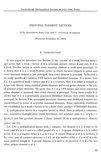Article
Full entry |
 PDF
(1.0 MB)
Feedback
PDF
(1.0 MB)
Feedback
 PDF
(1.0 MB)
Feedback
PDF
(1.0 MB)
Feedback
References:
[1] D. D. Anderson: Abstract commutative ideal theory without chain condition. Algebra Universalis 6 (1976), 131–145. DOI 10.1007/BF02485825 | MR 0419310 | Zbl 0355.06022
[2] D. D. Anderson, C. Jayaram and F. Alarcon: Some results on abstract commutative ideal theory. Studia Sci. Math. Hung 30 (1995), 1–26. MR 1318850
[3] D. D. Anderson, J. Matijevic and W. Nichols: The Krull Intersection Theorem II. Pacific J. Math. 66 (1976), 15–22. DOI 10.2140/pjm.1976.66.15 | MR 0435062
[4] R. P. Dilworth: Abstract commutative ideal theory. Pacific J. Math. 12 (1962), 481–498. DOI 10.2140/pjm.1962.12.481 | MR 0143781 | Zbl 0111.04104
[5] E. W. Johnson and J. A. Johnson: $P$-lattices as ideal lattices and submodule lattices. Commen. Math. Univ. San. Pauli. 38 (1989), 21–27. MR 0998864
[6] E. W. Johnson and J. P. Lediaev: Join principal elements and the principal ideal theorem. Michigan Math. J. 17 (1970), 255–256. DOI 10.1307/mmj/1029000473 | MR 0263710
[7] J. L. Mott: Multiplication rings containing only finitely many minimal prime ideals. Jour. Sci. Hiroshima. Univ. Ser. A-I. 33 (1969), 73–83. MR 0246866 | Zbl 0184.29202
[8] R. Padamanabhan and H. Subramanian: Ideals in semirings. Math. Japonicae 13 (1968), 123–128. MR 0245626

